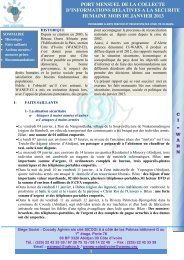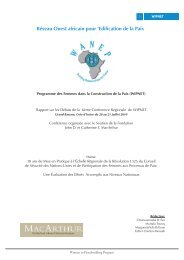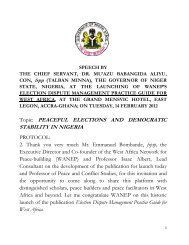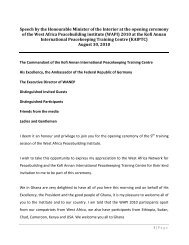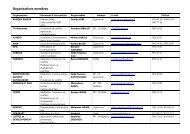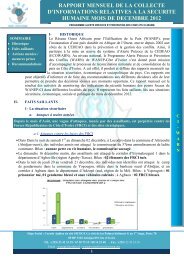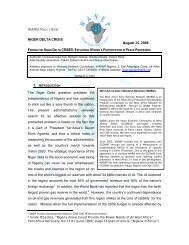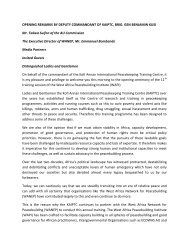DEVELOPMENT AND IMPLEMENTATION of National Action Plans ...
DEVELOPMENT AND IMPLEMENTATION of National Action Plans ...
DEVELOPMENT AND IMPLEMENTATION of National Action Plans ...
Create successful ePaper yourself
Turn your PDF publications into a flip-book with our unique Google optimized e-Paper software.
2. Institutional audit••This assesses the work <strong>of</strong> relevant government department on WPS issues, existinghuman and financial resources and persistent gaps and needs. Any meaningful NAPmust be backed by sufficient financial and human resources and based on realisticunderstanding <strong>of</strong> existing capacities, priorities, achievements, levels <strong>of</strong> commitment andchallenges.••An institutional audit will provide a government with institution specific information thataddresses these areas. An institutional audit aims to assess:»»The existence <strong>of</strong> gender policies and their implementation;»»The availability <strong>of</strong> human resources including personnel who have expertise on gender,peace and security issues;»»Existing gender training, financial resources and organizational culture;»»Help to identify on-going activities, gaps and areas <strong>of</strong> strategic priority related to UNSCR1325 and related resolutions within a specific government/department.••Also data collected during an institution audit can serve as a baseline for future M & E.Both context assessments and institutional audits have to be carried out during the preplanning/planningprocess and could be done by a Task force or by a consultant recruitedfor that purpose.Step 7: Building Political Will••Before beginning the formulation <strong>of</strong> a NAP, it is important to raise awareness aboutUNSCR 1325 (currently very low in most countries) and to build political will within eachgroup <strong>of</strong> stakeholders. Awareness-raising is particularly important within governmentministries that have not actively dealt with WPS issues.••Activities organized by CSOs, government institutions and international organizationscan contribute to the dissemination <strong>of</strong> information and to building momentum aroundthe planning process and will elicit the strong support and political will within both thegovernment and civil society for the action plan and its implementation.••Awareness-raising could be done through media campaigns, leaflets, meetings,workshops and discussion groups.••All planning meetings or workshops should also include components <strong>of</strong> awarenessraisingsince the stakeholders involved in the planning process <strong>of</strong>ten come to the tablewith different understandings and assumptions. These activities should start prior andcontinue during and after the formation <strong>of</strong> the action plan.Step 8: Establishment <strong>of</strong> UNSCR 1325 Focal Points within all StrategicSectors••For the successful development <strong>of</strong> a NAP, it is important to also establish focal pointswithin all strategic sectors such as Justice, Police, the military (Army, Navy, Air Force, etc),Health, social Works, Communication/Information, Media, etc and the line ministries.Regional/district/county focal points also need to be established in view <strong>of</strong> the multilevelimplementation <strong>of</strong> the NAP.15


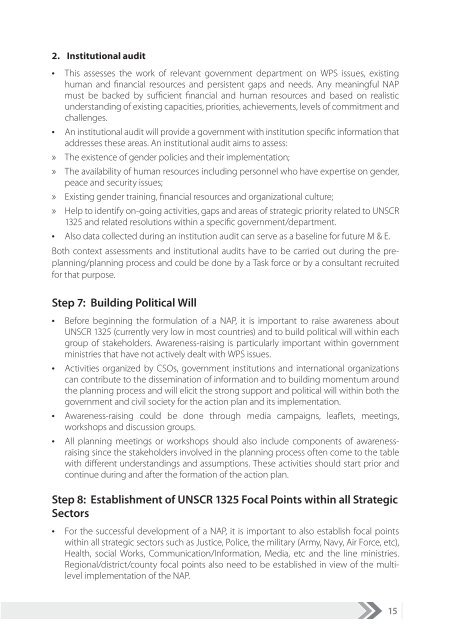
![English [266KB] - West Africa Network for Peacebuilding](https://img.yumpu.com/50460007/1/184x260/english-266kb-west-africa-network-for-peacebuilding.jpg?quality=85)
